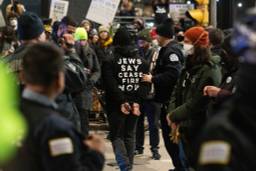
It’s hardly a secret that the New York City Police Department (NYPD) has undercover officers in all manner of places. The department’s spying on Muslim communities has drawn particular attention, but the NYPD also has a track record of infiltrating activist communities. Following a high-profile incident involving an altercation between a motorcycle rally and an SUV driver last month, we’ve now learned that that infiltration extended to Occupy Sandy, the disaster relief offshoot of Occupy Wall Street.
After the city (or certain parts of it, anyway) was shocked by the altercation that left one motorcyclist in the hospital and ended with the vehicle’s driver being beaten by several of the bikers, rhetoric about “criminal biker gangs” became heated. Republican mayoral candidate Joe Lhota told the New York Post that recently-passed city laws to curb stop-and-frisk “have had a chilling effect among the NYPD” and are leading to a rise in violent crime.
There’s just one little problem: At least one of the bikers who was part of the assault was a cop himself.
As the story becomes clearer, we’ve learned that Detective Wojciech Braszczok, 32, was off-duty when he participated in the ride, making his claims that he didn’t come to the aid of driver Alexian Lien because he was afraid to blow his cover a little harder to believe. The detective has apparently been arrested and charged with riot and criminal mischief after video surfaced of him punching and kicking Lien’s vehicle.
The revelation that Braszczok participated in the so-called riot has calmed some of the city’s law-and-order freakouts, but it’s also brought further revelations in its wake — including that one of his undercover assignments was infiltrating Occupy Wall Street.
It is a shock to absolutely no one, of course, that the NYPD had undercovers at Occupy. The NYPD has eyes everywhere, as Jim Dwyer at the New York Times points out:
The city now has a sturdy legion of undercover officers who have taken up residence in many surprising regions of civic life. Much of this began in early 2003, when a federal judge lifted many restraints on spying by the Police Department. The city had been failed by the federal intelligence services, and thousands died on Sept. 11. Police Commissioner Raymond W. Kelly and Mayor Michael R. Bloomberg created an independent intelligence capacity.
So before and during the Iraq War, the organization of antiwar rallies was regarded as a fit matter for police surveillance; so were the monthly Critical Mass bicycle rallies, as well as groups protesting at the Republican National Convention in 2004, and a range of Islamic facilities, from mosques to college student clubs.
It’s perhaps slightly more surprising — but only slightly — that the NYPD felt the need to keep an eye on the Sandy relief work being done by Occupiers. Even billionaire soon-to-be-ex-Mayor Michael Bloomberg praised Occupy Sandy’s work, albeit grudgingly and perhaps in an attempt to deflect anger at his own failures. The immediate aftermath of Sandy brought an apparent détente between police and the organizers who’d been arrested, pepper-sprayed and repeatedly ejected from the park they’d called home. Meeting the immediate needs of New Yorkers without power, food, or transportation seemed to supersede all else.
It may not surprise us that peace went only so far, and that officers were in fact still present, trying to infiltrate an open organization that accepted donations and help from anyone who walked in. But the degree to which we’re resigned to this constant surveillance should worry us. If the NYPD’s biggest priority after a massive storm that left thousands homeless, trapped or stranded was making sure the people bringing them fresh water and medications weren’t slipping a little radical propaganda in with the hot meals, that should raise questions about what the police force is good for in the first place.
Last fall, after Sandy, I went out to the Rockaways to see what the storm had done to that part of the city. I spoke with residents who told me that the police were little help as they attempted to clean out flooded homes, check on neighbors and care for one another. Kenyatta Hutchinson, who had been flooded out of his house along with his wife and child, told me that he was afraid to remove his flat-screen TV from his own apartment because he might be accused of looting his own belongings. “All I see is cops, and they’re still harassing us,” he told me, a sentiment that was echoed by many of his neighbors in Arverne, a mostly black neighborhood.
New York’s communities of color have long known that the police are unlikely to help them in a crisis. The people who panicked over the motorcyclists are perhaps learning that lesson for the first time right now, as news of Detective Braszczok’s actions spreads.
But we shouldn’t forget that the real story here is the depth and breadth of the surveillance state, the way police departments and federal agencies have access to our emails and cell phones and infiltrate our political events. As Dwyer wrote, “One of the large, undiscussed questions of such surveillance is how civic dialogue can be influenced or distorted by police agents — perhaps as provocateurs, or possibly with no motive beyond maintaining cover.”
When the issue at hand is not just civic dialogue, but life-saving disaster relief work, how much does the NYPD’s intrusion hurt?

I hope you found this article important. Before you leave, I want to ask you to consider supporting our work with a donation. In These Times needs readers like you to help sustain our mission. We don’t depend on—or want—corporate advertising or deep-pocketed billionaires to fund our journalism. We’re supported by you, the reader, so we can focus on covering the issues that matter most to the progressive movement without fear or compromise.
Our work isn’t hidden behind a paywall because of people like you who support our journalism. We want to keep it that way. If you value the work we do and the movements we cover, please consider donating to In These Times.
Sarah Jaffe is a Type Media Center Fellow, co-host (with Michelle Chen) of Dissent magazine’s Belabored podcast, and a columnist at The Progressive. She was formerly a staff writer at In These Times and the labor editor at AlterNet. Her previous books are Work Won’t Love You Back: How Devotion to Our Jobs Keeps Us Exploited, Exhausted and Alone and Necessary Trouble: Americans in Revolt, which Robin D.G. Kelley called “The most compelling social and political portrait of our age.” You can follow her on Twitter @sarahljaffe.




